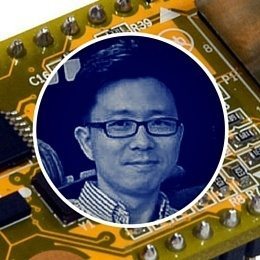Rick Bullotta from the IoT platform company Thingworx discusses how the IoT is not following the typical tech adoption cycle, the ‘Intranets of Things’ and its value, and what industries are leading adoption in the platform market.
This is the seventh segment in the Postscapes Interview Series with some of the top people influencing the Internet of Things.
Interview:
Who are you, and what do you do?
I’m the CTO and co-founder of ThingWorx. We’ve created what we consider the first platform for “connected applications”. My job is to guide the strategy and architecture for our product offerings, but I get my hands plenty dirty with code as well. My background is really an “all of the above” answer. I’ve worked in the steel industry in operations and engineering roles, spent a few years in IT, worked as a systems integrator in the manufacturing space, was a strategic accounts/sales executive, product manager, CTO and co-founder of Lighthammer (later acquired by SAP), VP in product management and research at SAP, and of course now changing the world at ThingWorx.
How do you think the companies and your own background in the manufacturing world has influenced the development of Thingworx?
We’ve come from a world that is used to solving really difficult problems in a very challenging environment. A typical manufacturing enterprise probably has 400+ different types of IT and automation systems to deal with, so integrating legacy is a must (same for the IoT). In a manufacturing application, when things fail, people can get hurt, the environment can be polluted, and significant economic losses can occur. You also learn that if something can go wrong, it will. And you build software that tries to deal with those realities. I’ve also gained an appreciation for the incredible amount of tribal knowledge that exists in the real heros of manufacturing who are out there working on the plant floor. We’ve made a conscious decision to integrate collaboration and the human element as an integral part of our platform. Probably as a side effect of this, I utterly despise the term “M2M”. The real need and the real value is when people, machines, and information systems are all connected.
How do you view the term “Internet of Things”?
Interesting question. I personally think the term is one of those memes that, if you ask 100 people what it means, you’ll get 104 answers. I consider it somewhat “damaged” as a result of the original RFID-centric definition of a few years ago, so I’d love to see that cord being cut once and for all. I also don’t really see the analogy to the “internet” being accurate. The “internet” was the plumbing, but the “web” was really brought the value. So I’m partially biased towards Dom Guinard and Vlad Trifa’s “web of things” term. Also, the reality today is that a significant number of the devices that will be connected in the near term (energy, manufacturing, water, transportation, healthcare, and remote service management) will be connected via private networks. I call that the “Intranets of Things”. There are literally millions of these networks, and there is amazing value to be unlocked not only *within* those networks but at the interstititials/boundaries between those networks. I’m a passionate believer in the power of the network effect – Metcalfe’s law.
Where do you see the Internet of Things and its technologies creating the most impact?
Near term, in the various “intranets of things’ areas described above. Medium term, in smart public infrastructure and safety/security systems. Longer term, the consumer space. It is interesting that this is an inversion of the typical technology adoption cycle. What I find interesting is that some of the companies that are starting with the consumer point of view have had some substantial challenges to deal with. Those challenges include no clear value proposition/revenue opportunity, a lack of experience (and therefore a lack of capability) in mission critical/secure/reliable applications, and an unclear go-to-market model. We’re going to get traction in the consumer space largely through our OEM partners, not directly. On the other end of the spectrum, you have the early M2M companies who are unfortunately saddled with dated, limited and inflexible technology (and business models). It’s really a fantastic opportunity for a company like ThingWorx to change the game.

What are you currently working on or are most excited about?
We just released the 2.0 version of our product, which includes some really mind blowing technology for creating the user experience for “connected applications”. It really demonstrates what is possible today with HTML-based UI’s, fed from a broad range of web services and content, along with some pretty cool mobile capabilities. Yet this couldn’t have been possible without the ThingWorx platform itself, exposing “things” in a very discoverable and consumable way.
Are there particular market segments (manufacturing, m2m, energy, etc) that are showing early uptake in the platform sector?
I think you’ve hit on the main ones. We’re also seeing significant activity in building automation, intelligent urban infrastructure, water treatment and distribution, home automation, and healthcare.
Any unique or unexpected ways people have been using your platform and tools?
Absolutely, but if I told you, I’d have to kill you.  Hang tight for a couple of months, and we’ll be sharing some incredibly fascinating examples of what is possible with connected applications!
Hang tight for a couple of months, and we’ll be sharing some incredibly fascinating examples of what is possible with connected applications!

Shout-outs: Any sites/people/articles or books that have inspired you lately?
As I mentioned early, I’m a fan of the web of things guys. We were colleagues at SAP Research but never really had a chance to work together then. Maybe we’ll change the world out here in the “real world”. I’ve also been influenced by Bruce Sterling’s “Shaping Things” and Alvin Toffler’s “Third Wave”. I’ve also had the opportunity to re-engage with one of my professional mentors (Phil Huber, co-founder of Wonderware and now leading the charge for our mashup engine in ThingWorx), which has been an incredibly cool experience.
Thanks for taking the time to talk to us.





